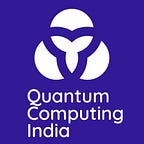Qubits Implementation & Quantum Hardware 102
As part of the peer learning series, Quantum Computing India had a session on Qubits Implementation & Quantum Hardware 102 by Nilay and Kedhar. Here’s a quick log of the session. In the end, you will find full video link.
Table of Contents
- Reversible Circuits
- Quantum Circuit Model
- Introduction to Qubits
Reversible circuit
Irreversibility bits are lost. Eg- AND, XOR Reversible version of XOR — CNOT (controlled NOT)
What
no information is lost.
In principle — can be carried out with no heat released
AND:
CNOT
Why?
Landauer’s principle
For every irreversible operation you do, a minimal amount of energy is dissipated: Q > ln2KbT based on 2nd Law of Thermodynamics
This limit is expected to be hit by 2050 !!!
Quantum Mechanics makes stringent requirements — A quantum system can never loose information over time.
Losing information means losing states meaning decreasing entropy.
How?
Eg — AND,XOR or ADDER — very important operations. In reversible — we try to change the MODE of operation: add something in the output to make it a one one function. Thus, fundamentally different Eg — ADDER → ADDER — SUBTRACTOR its now like n equations in n variables — deterministic.
Reversible in ALL abstracts — even in physical implementation (transistor level operations) Algo -> HighLevel Lang -> Machine Code -> Computer Architecture -> Gate Level -> Physical Implementation
CNOT using electron spins as qubits — frequency required to flip the spin of an electron depends on the spin of neighboring electron. So, with a particular frequency, spin can be flipped only if the neighboring electrons spin is ni accordance — control qubits
In Principle, any unitary computation on n qubits can be done using CNOT and single qubit gates — Universal Gates.
Types
- NOT
- Hadamard Gate (used to create superposition)
- CNOT/Feynman
- Toffoli Gate
- Fredkin
- Peres
Quantum cost —
It is basically number of primitive reversible gates such as C-NOT, and NOT gate ( both 2x2 as well as 1x1 ) utilized in constructing a quantum circuit.
Quantum Circuit Model
In terms of Matrices — always unitary
Classical to Quantum —
These gates are mostly used in quantum circuits, and are implemented in a classical way on FPGAs.
Which gates to use? depends on our vertical!
Physical Implementation depends on the technology or the physical property that we decide to exploit.
Introduction to Qubits
- Classical bit
Bit — smallest unit of information in computing in classical world
- BJT
CMOS technology -
- Quantum Bit
Same abstract idea — but in quantum realm — any system that can store superposition information of multiple states can be used as a Qubit.
-Photonic
Physical Property as State
1. Polarization (Polization Qubit)
2. which of the two paths the photon is travelling (Dual Rail Qubit)
- 3. whether the photon is arriving early or late (Time-bin Qubit)
-State Measurement
Photon Detectors
Logic Implementation —
- Solely using beam splitters, phase shifters and mirrors(45 deg)
- Very .stable over long distances — Would prove very useful in QKD
>Mbps, >400km
Challenges
- Hard to achieve — single photon source
- Quantum Dot:
- Omnidirectional — can be narrowed down to some extent using resonators
- Not very deterministic — difficult to scale up to large number of qubits
- no mass or charge => hard to locate or measure. Leads to high error probability
- Aligning all the beams to process photons at the correct angle and timing
Here’s is the complete link of the video —
Quantum Hardware Team:
Join us in the #peerlearning series every Sunday 4–6 PM IST.
Book your slots here —
